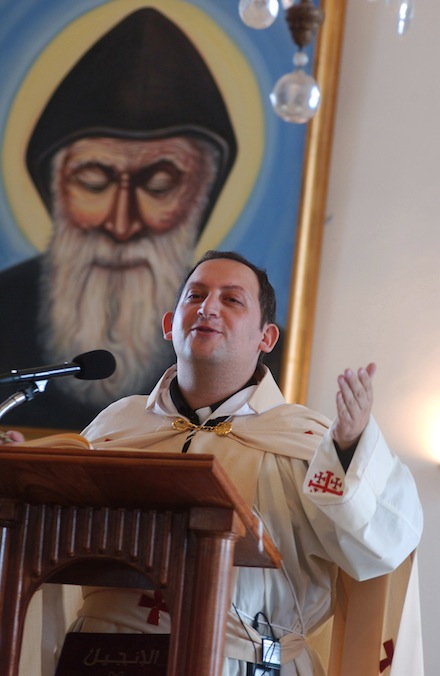Who is St Charbel?
The Church should follow St Charbel’s example and fix its eyes on the Blessed Sacrament
By FR ALEXANDER LUCIE-SMITH on Monday, 22 July 2013

A priest preaches in a northern Lebanese village with a painting of the beloved Saint Charbel in the background Photo: CNS
Who is St Apollinaris? According to the Ordo – the special little book which tells you which feast to celebrate – his optional memorial is July 20. Naturally, I celebrated his memorial, as I celebrate all memorials, optional or not, as a matter of course. As it happens I have been to the saint’s basilica which is outside Ravenna, and called Sant’ Apollinare in Classe. Once this church stood at the sea’s edge, where the Roman imperial fleet (classis) lay at anchor. Now the sea has receded, and all that is left of its maritime character is the name. There is also a basilica dedicated to the saint in Ravenna itself. Both are famous for their mosaics.
Ravenna, as most readers will know, is home to the world’s most wonderful mosaics – better than Rome, better than Constantinople – a relic of the relatively brief time when this now small town was the capital of the Western Empire. The Empire was then in its decadence, but clearly it was flourishing artistically. Ravenna, especially on a freezing cold day when snow lies on the ground, which was how I saw it, is immensely worth visiting.
To answer the question posed above, St Apollinaris, first Bishop of Ravenna, is a martyr of ancient times who has only recently been restored to the general calendar. Very little is known about him for sure. I am not altogether clear why he was restored to the General Calendar in 2002, but there we are.
On July 24, there occurs the optional memorial of another saint who may be unfamiliar to most, and who has also been placed in the general calendar recently, and that is St Charbel the Miracle-Worker. To most, not all. Every Lebanese will be familiar with this saint of the nineteenth century, a Maronite monk and hermit, who was famous for his devotion to contemplative prayer, and whose image is found on virtually ever street corner in the Christian parts of Lebanon. In fact a large picture of St Charbel or his statue usually announces the confessional allegiance of the quarter you happen to be entering. Just as the Maronites revere St Charbel, so the Shia revere the late Ayatollah Khomenei, and decorate their quarters with his picture, or at least they did when I was last in Lebanon about fifteen years ago. The only other place I have been to where confessional allegiance is so clearly marked is, of course, Northern Ireland.
But there is another place where St Charbel is equally revered, and that is Mexico. Embedded in its vast population is a small community of Lebanese Maronite immigrants, the most famous of whom is Carlos Slim, Mexico’s richest man. The Maronite incomers brought with them their devotion to St Charbel, and this is why virtually every Mexican church has a picture or a statue of the saint, which is the focus of much devotion. This is remarkable considering St Charbel was canonised as recently as 1965.
St Charbel deserves attention, not simply because of his reputation as a miracle worker, but because he is a fine example of prayer. In his picture his eyes are always cast down, and for the last decades of his life he practised strict custody of the eyes, only raising them to look at the Tabernacle and the Eucharist. The Church too, like Charbel, needs to keep its eyes fixed on what really matters: the Divine, and more specifically, the Blessed Sacrament.

No comments:
Post a Comment